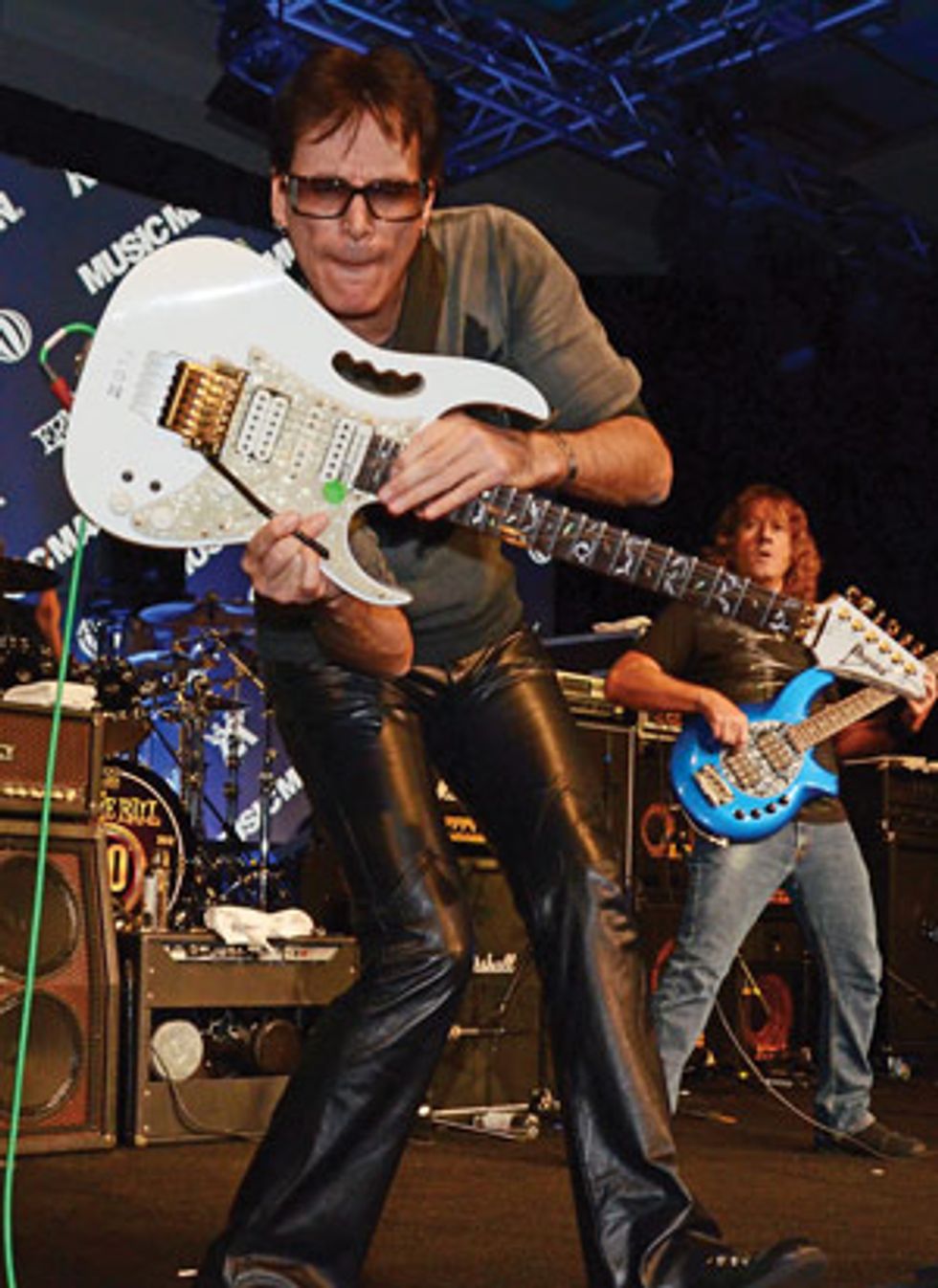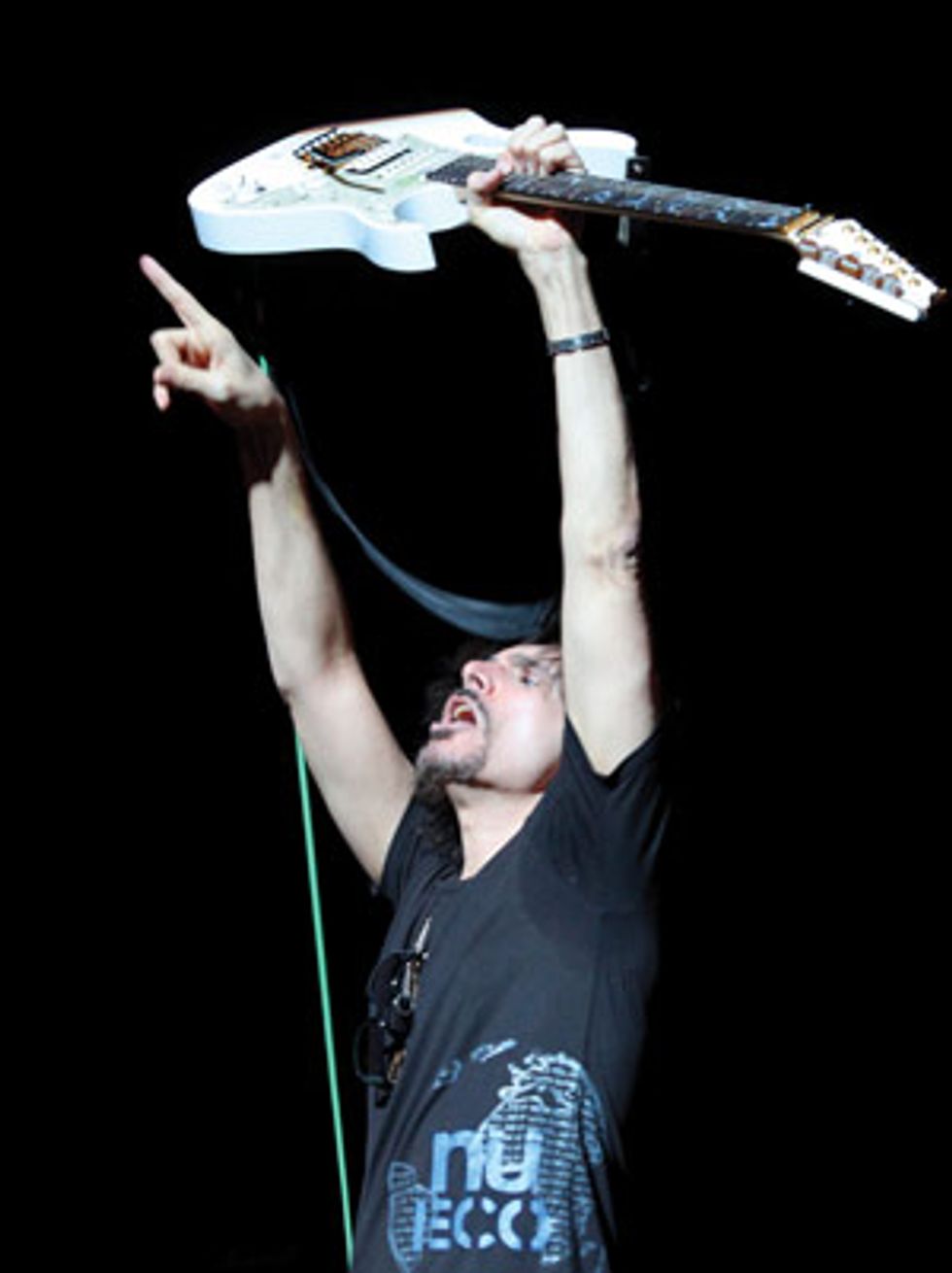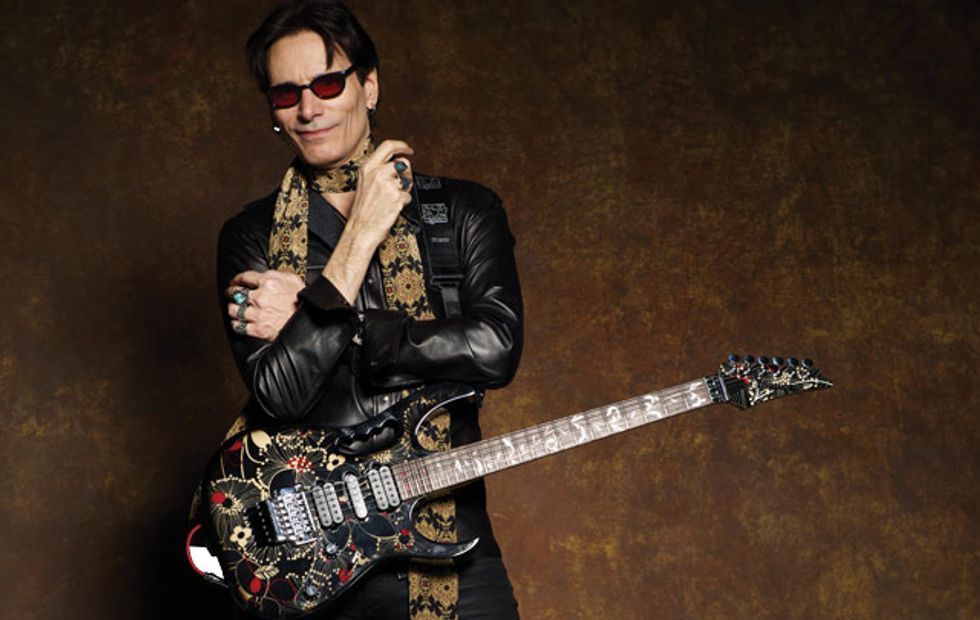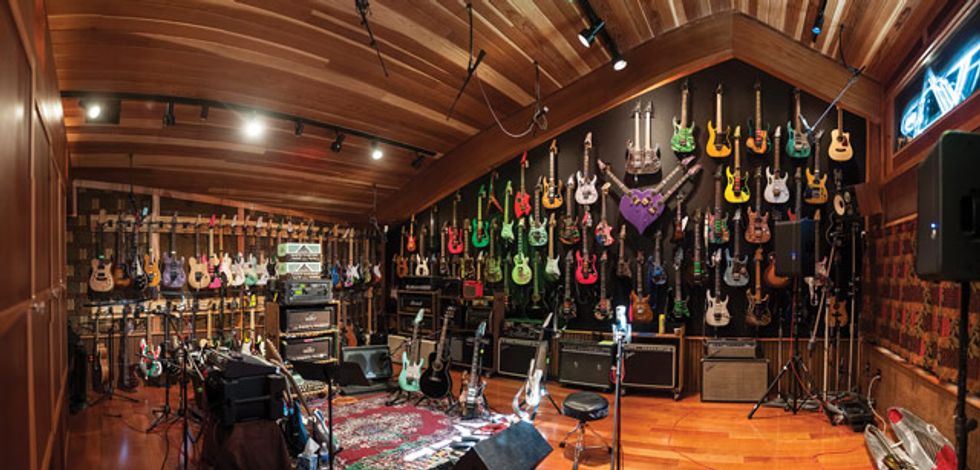Photo by Larry DiMarzio
Steve Vai first gained notoriety nearly three decades ago when he joined forces with David Lee Roth after the famous frontman’s split with Van Halen. Almost immediately, Vai usurped Eddie Van Halen’s throne as the king of rock guitar, and throughout the subsequent decades Vai’s continual innovations have distinctly changed the sound of rock guitar. What has always significantly differentiated Vai from other virtuosi in the annals of rock history is that, although he can burn with reckless abandon and fire, he’s also an academic at heart—a passionate player whose mastery of music theory, composition, and orchestration could rival a Julliard professor. While still in high school, Vai wrote his first orchestral piece, an arrangement he called “Sweet Wind from Orange County.” Soon after, he landed a gig with Frank Zappa by sending him a transcription of Zappa’s impossibly difficult piece “The Black Page.”
But even after decades of reigning as one of the world’s most formidable guitar icons, Vai continues to hone his skills as a modern classical composer. In fact, he doesn’t even need a guitar to satiate his musical urges. In some cases, a pencil and manuscript paper are all the man needs. Releases such as 2004’s Piano Reductions Vol. 1 feature strictly piano arrangements of Vai’s compositions (performed by frequent collaborator Mike Keneally), and just this past November Vai premiered an orchestral composition sans guitar entitled “The Middle of Everywhere” that was performed by the Noord Nederlands Orkest (North Netherlands Orchestra). Of course, he has also indulged his inner guitar geek by not only writing for but also performing live with the Metropole Orchestra on releases like 2007’s double-live album Sound Theories Vol. I & II.
For a lot of guitarists, an album like Sound Theories would be their magnum opus—after all, how do you top something as grand as writing for and performing with a symphony orchestra? But not for Vai. His latest release, The Story of Light, is the second installment of a rock-opera trilogy that began with 2005’s Real Illusions: Reflections. As you’d expect, Story of Light is much more than just an instrumental shred fest—it features Vai’s trademark genre-busting arrangements and an unlikely cast of guests, ranging from a gospel choir to vocalists Aimee Mann and (The Voice finalist) Beverly McClellan.
We caught up with Vai to talk about his latest epic, his take on the new Van Halen album, and whether he’d still be content if he were just a mailman rather than a guitar hero.
What’s the concept behind Story of Light?
It’s sort of like a rock opera. I hate using
that term, because I don’t like opera at all,
but basically it’s the second installment of
the Real Illusions trilogy. My plan was to do
this story, and then at the end I would take
all of these records and kind of amalgamate
them into the story—and then, maybe,
the songs would be put in proper order and
there would be new stuff.
If somebody picked up Story of Light before
Real Illusions, would the context be lost?
They’re not in a sequential, chronological,
linear order. It’s not the kind of record
where you have to follow the concept and
know the story in order to enjoy the music.
I wanted it, first and foremost, to be enjoyable
music. Then if you read deeper into it,
each song tells a little piece of the story.
The Story of Light spans a variety of
styles. Does having such a broad range
make it harder to unify things across
the three albums?
What I’m setting out to do is just do what I
really like to hear in music, which is to create
diversity—but with unique dimensions to it.
“Creamsicle Sunset,” for instance, is a clean
guitar sound and a simple piece of music.
Then you listen to something like “The Book
of the Seven Seals,” which is like “contrast”
with a capital C. A lot of people are comfortable
making records that have a musical
theme that’s in every single song. It’s like,
“Okay, this is our 7th string and we’re tuning
down and we’ve got a lot of distortion. We’re
going to do some soft parts now and then …
but this is us.” You could listen to song number
one and song number 10, and it would
sound like the same band. That’s what a lot
of people do, and that’s great, but there’s no
rule that you have to do that. The only time
people believe you have to do that is when so
many other people do it that they think this
is the normal way to do things.
Inside Steve Vai's Harmony Hut home studio. Photo by Lindsey Best
“Creamsicle Sunset” starts off with the
simple opening triad and inversions, and
then morphs into some delicious dissonances
that most rock guitarists probably
couldn’t gracefully maneuver.
Yeah, a song like that was like a little gift for
me, because it was so simple. I picked up the
guitar and I was just playing these triads—like an exercise you do when you’re learning
chords—but this particular time I played it,
it transcended the exercise and it sounded
like music. The whole song unfolded to me
and all I needed was that first bar—the triad
thing. When I came up with that idea, I had
my iPhone and I turned it on and played
those first three chords and left myself a
voice note, “Create a track that has these
inversions that keep building and building,
and going higher and higher, and has the
really juicy, beautiful chords in between.”
The whole thing was done before I finished
playing the third triad. My goal was that
every note in the song had to have its own
zip code, and it had to sound like a little
church bell that it owns. When you imagine
these things, that’s how you get them
to come into reality.
Parts of “John the Revelator” are reminiscent
of the scene in Crossroads that’s
right before the grand-finale guitar
duel—and then it morphs into “The
Book of the Seven Seals.” Were the two
songs conceived independently?
I came across this version of “John the
Revelator” online. The vocal arrangement
was done by two guys, Paul Caldwell
and Shawn Ivory, and sung by a high
school choir called The Counterpoint
Singers. I contacted the woman that ran
the choir and she sent me a cassette of
the only stereo recording they had. I put
it into Pro Tools, cut it up, and built the
song around it, but it still wasn’t good
enough. The piano was dull, so I hired
10 of L.A.’s finest and they came in and
sight-read this very intricate arrangement.
Then I triple-tracked them, so it’s
like a hundred voices.
But as far as “John the Revelator” and “The Book of the Seven Seals,” they were one song. It was a vision. To go from “John the Revelator,” which is heavy guitars and tuned-down octave dividers with these gospel singers—that to me is always the way gospel should be presented, heavy, hardcore guitars playing very musical things—to the second part, with this extremely white-sounding, Republican, Midwestern vocal arrangement. That’s such a contrast.
How did Beverly McClellan get
involved on that track?
I needed somebody to sing “John the
Revelator” and I thought I could do it,
but it wasn’t in my range. When I hosted
an event for NARAS [National Academy
of the Recording Arts and Sciences] with
Sharon Osbourne, I went into the audience
to check out what it sounded like
and this woman, Beverly McClellan, took
the stage and just tore it up. The moment
I heard her sing, I was just stunned dead
in my tracks. I thought, “She’s gotta
sing ‘John the Revelator’ for me.” I was
also thinking, “I don’t know. She doesn’t
know me and she probably thinks I’m
this crazy shredder guitar player,” which
a lot of these people who don’t know
anything about me just think. When I
got backstage, she was there waiting in my
dressing room with her CD and she said,
“I’m a big fan. I know your music and I’d
love to give you this CD.” I said, “Look,
we’ve got to do something.”
“No More Amsterdam” features Aimee
Mann, who also cowrote the song. I
understand she was at Berklee College of
Music when you were there.
Yeah, I was going to Berklee and Aimee
lived in the same building as me, four doors
down. We knew each other from saying
“Hi.” My girlfriend at the time, who’s now
my wife, Pia, was very good friends with
her—they were actually in a little band
called the Young Snakes. I had this weird
preconceived idea—because I was very insecure
at that time—that she thought I was
a crazy, long-haired shredder and that I was
doing all this progressive stuff. When you’re
critical and you’re insecure, you think that
anybody who’s not doing the thing you’re
doing doesn’t have any appreciation for
what you’re doing, and the people who are
doing it always think they’re doing something
better than you.
Many musicians feel that way.
Most people feel that way. Aimee wasn’t
like that at all, but I didn’t know that. So
when I was doing “No More Amsterdam,”
I started to write the lyrics and I just
had a really hard time. Pia said, “Well,
why don’t you call Aimee?” I thought,
“Aimee doesn’t want to have anything to
do with me.” But I couldn’t have been
more wrong. She’s way above all that stuff.
It was my own insecurities that kept me
from going to her.

Steve Vai performs with a band that includes Dixie Dregs bassist Dave LaRue at the Ernie Ball 50thanniversary party at Winter NAMM 2012 in Anaheim, California. Photo by Marty Temme
You seem to always have a real clear picture
of what you want. Was it hard for
you to make compromises with Aimee?
For the most part, I’m very controlling—controlling in the sense that something
has to feel and sound a certain way to
me. Reaching out to somebody that’s able
to deliver that is part of the controlling
nature. Her contribution fit perfectly
with my control-freak nature, because my
control-freak nature said, “Give it to her to
do whatever she wants with it, because it’s
going to be great.” We talked about it and
she just fit these lyrics in that were just so
much better than anything I think I ever
could have come up with. She also made
some vital suggestions about the form of
the song.
Let’s talk gear. What’s your main rig
right now?
Well I have a new head, the Carvin Legacy
3 VL300.
Is its smaller size designed to compete
with the lunch box-type amps that are
everywhere nowadays?
It’s designed to be a lot more convenient—smaller but still packing the 100-watt wallop. It’s a very simple, 3-channel
amplifier. You open up a Legacy, and
you’re going to see some very powerful,
simple wiring. In the process of designing
these amps, I’ve always been a real stickler
for the signal path and the motherboard,
and how many components are going into
it. Because every time you add a channel
or a loop or a master volume, it compromises
the main signal.
Do you use your Axe-Fx II just for effects?
Yes, just for effects. It’s the most transparent
piece of gear I’ve ever heard. With most
other pieces of outboard gear for the guitar
that I’ve played, there’s always a price to
pay—like latency, a roll-off at a particular
frequency, or a noise that happens. Or
there’s just programming that’s completely
and utterly ridiculous and nonsensical and
designed by nerds who want to fascinate
themselves with their intellect and couldn’t
give a shit about the mind of a musician.
There are people who do that because
they can’t play and they’re fascinated with
the electronics and make shit impossible
to figure out. I’m really simple, you’d be
surprised. My music might lead you to
believe otherwise, but I like things to make
sense. The Axe-Fx is the best-sounding
pass-through processor I’ve ever heard.
Tell us about the new pickups you
designed with DiMarzio—what tonal
characteristics were you going for?
They’re called Gravity Storms, and we’ve
been working on them for about a year.
If I were to explain, I’d say they sound
more analog to me than digital. All pickups
are analog, obviously, but you know
how when you hear something that’s
analog? The Evolution pickups [stock
units in Vai’s Ibanez signature models]
are very high output and have a very fat
bottom end and a very bright top end.
What I wanted with the Gravity Storms
was maybe a little less output—because
then I could crank other things. I don’t
know if they actually ended up with less
output, though, because we went through
so many pickups until I heard something
that felt really right.
Is it true you recently changed
string types?
I use Ernie Ball, but they just sent me
these new Cobalt strings. At first I didn’t
like them. There was something very
stretchy and slinky about them that felt
uncomfortable. I was so surprised that
somebody could make strings that felt
so different and responded so differently
than what anyone else was making. If
you took any brand of strings and put
them on my guitar, I’d be hard pressed to
tell you whose they are—because a lot of
these strings companies get them all from
one source. But Ernie Ball really processes
strings to make different sounds and different
feels.

Vai gets a natural monkey grip during the 2010 Experience Hendrix tour at the Star Plaza in Merriville, Indiana. Photo by Barry Brecheisen
When I got these Cobalts, I was set off a bit because of the slinky-ness, like I said. I told Thomas [Nordegg, Vai’s guitar tech] to take them off the guitar, but he left them on. I had them on five guitars here at the house, and I just started using them—I don’t like taking time to change strings—and I started to get it. I was like, “Wow, they’re so much more controllable.” And the way the notes ring together when you clang them is very different, so I really grew into them and I like them a lot now.
You often pit guitar against timbres rock
guitarists don’t usually encounter—like
the orchestras or the gospel choir in
“Book of the Seven Seals.” Do you
accommodate your guitar sounds to fit
those situations?
Not usually. It’s according to how you
play and how you process your sound.
When I’m doing stuff with an orchestra,
a smoothly distorted melody guitar can
blend in very nicely with a violin or some
other instruments. As an orchestrator, you
have to know, “How does tuba compare
to a xylophone?” They’re very different
instruments—they’re organic instruments,
because you’ve got to blow into one of
them and you’ve got to hit the other one.
There are no electronics involved. That’s
the difference, and that’s the tone quality
difference in the guitar that makes it stand
separate from all the other orchestra instruments.
It is difficult to blend—very difficult.
You have to know how to orchestrate
it to speak a particular way. But this is all
subjective to the composer’s ear. This is my
vision for it.
Have you heard the new Van Halen album?
Yeah, I was really surprised. I thought the
sound was very visceral—very distorted and
very high energy. I was relieved, because I
was afraid Edward was losing his ability to
really play because I had heard rumors that
he had stopped playing for a long time. But
I was really surprised. It sounded like he had
that fire. It wasn’t the shell of greatness—I
was hearing greatness again. What was cool
was the way Edward and Alex can still lock.
They really locked in on hyper-speed stuff,
these grooves. I think I could take like three
or four songs at a time—it’s just so kinetic.
I was really surprised at Dave Roth, too. I
know how hard he works, but he kept working
harder and now his vocal range is much
greater than when I was working with him.
Really?
Yeah, I’m not placating. It’s very obvious,
and when I was hearing these notes I was
like, “Whoa.” I know Dave and I know that
he worked really hard. People don’t see that
because they don’t know him.
In your music, you’ve espoused experimentation
and taking guitar to the outer
limits—and, against the odds, you’ve been
very successful. Since you’re involved in
the business side of your Favored Nations
label, do you view submissions differently
now than you would have as just an artist?
If something stimulates you on an intellectual
or musical level but you think it
will have limited appeal, even within this
niche market, will you release it?
Well, I have—but it’s not that easy. For years
with Favored Nations, I plummeted money
into artists that lost a lot of money. Usually,
if you get it in a store, if it doesn’t sell, they
send it back. You can ship a half a million
records and get 499,000 back. So there are
a lot of things that go into deciding whether
to release a record: Is the artist capable of
continuing a career? Are they gifted?
Steve Vai's Gear
Guitars
Ibanez signature electrics
(JEM7V, JEM77, JEM70V, and
UV777), Ibanez signature acoustics
(EP5BP, EP10BP)
Amps
Carvin Legacy 3 VL300 heads,
Carvin Legacy 4x12 cabs with
Celestion Vintage 30s
Effects
Fractal Audio Axe-Fx II, Ibanez
Jemini, Morley Bad Horsie wah,
Morley Little Alligator volume
pedal, DigiTech Whammy
Strings, Picks, and Accessories
Ernie Ball Cobalt .009–.042 sets,
Ibanez heavy picks, Fractal
Audio MFC-101 MIDI foot
controller, DiMarzio cables and
ClipLock straps
When I listen to submissions, I listen for people who I feel have a vision of their own. When I come across things like that, I think, “What can I do for these folks?” Because a lot of musicians just don’t have an understanding of the business—but I do. I’ve thought, “I can’t put this out, because it’s just not going to sell at all, so what can I do?” So I started Digital Nations, and it’s only digital releases. We have digital distribution in several hundred stores around the world. For, like, a hundred dollars you can sign up and get your music distributed around the world. In that regard, we’re more of a service than a label—I have to make it make economic sense.
Long ago, you said if you were a mailman,
you’d be just as content. Do you
still feel that way?
I feel even more so, because you take who
you are wherever you go. It doesn’t matter
if what you’re doing is wildly successful or
not. What matters is if you find satisfaction
in it. I know that sounds cliché, but
it’s the truth. And I’ve seen it. You know
I’ve been there and back and there and
back again. The bottom line is you can be
playing to 30,000 people and have a hit
single and multi-platinum record, but if you
don’t like the music you’re playing and if
the guys in the band are assholes but you’re
tolerating them because of what’s at stake,
you’re gonna be unhappy and that whole
period of your life is going to have a dark
shadow over it—and that’s going to be your
memory. What’s that worth? It’s not worth
anything. If you can let go of that and find
the thing that excites you the most and cultivate
that, you’re always going to be happy.
And usually that’s the thing you’re going to
be most successful at.
YouTube It
For a taste of Steve Vai’s quirky brand of virtuosity, check out the following clips on YouTube:
Vai performs “The Attitude Song”—one of
his seminal classics—with the Metropole
Orchestra in 2008.
Three necks are better than one, as Vai demonstrates
during this 2003 G3 concert (with
Yngwie Malmsteen and Joe Satriani) in Denver.
From 4:34–4:40, Vai plays the most insane
5ths-based sequence ever.
Vai and bass god Billy Sheehan perform “Shy
Boy,” the unison-filled shredfest that symbolized
their respective instrumental powers during
their stint with David Lee Roth in the mid
’80s. Here, Sheehan takes vocal duties.










![Rig Rundown: Russian Circles’ Mike Sullivan [2025]](https://www.premierguitar.com/media-library/youtube.jpg?id=62303631&width=1245&height=700&quality=70&coordinates=0%2C0%2C0%2C0)















![Rig Rundown: AFI [2025]](https://www.premierguitar.com/media-library/youtube.jpg?id=62064741&width=1245&height=700&quality=70&coordinates=0%2C0%2C0%2C0)




















 Zach loves his Sovtek Mig 60 head, which he plays through a cab he built himself at a pipe-organ shop in Denver. Every glue joint is lined with thin leather for maximum air tightness, and it’s stocked with Celestion G12M Greenback speakers.
Zach loves his Sovtek Mig 60 head, which he plays through a cab he built himself at a pipe-organ shop in Denver. Every glue joint is lined with thin leather for maximum air tightness, and it’s stocked with Celestion G12M Greenback speakers.











